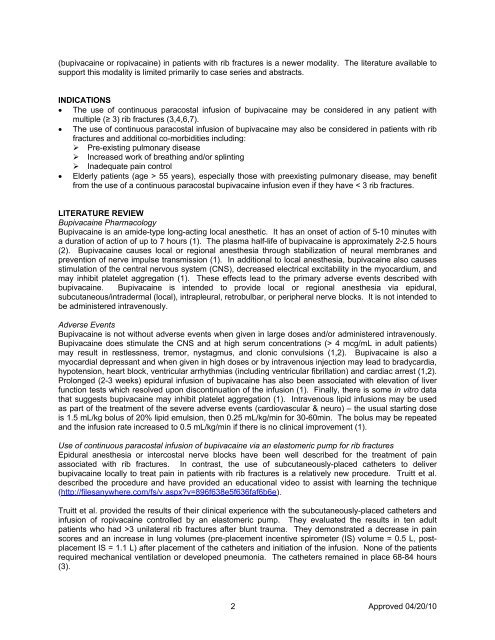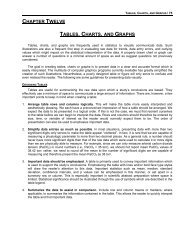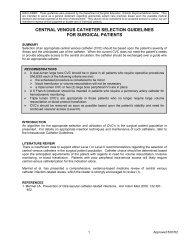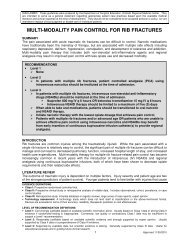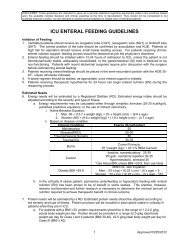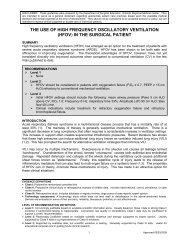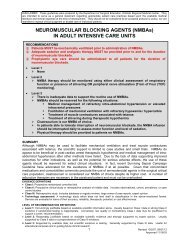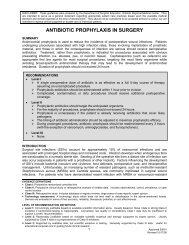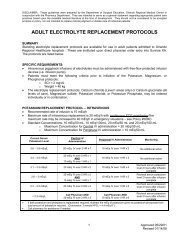Paracostal Infusion of Bupivacaine for Management of Rib Fracture ...
Paracostal Infusion of Bupivacaine for Management of Rib Fracture ...
Paracostal Infusion of Bupivacaine for Management of Rib Fracture ...
Create successful ePaper yourself
Turn your PDF publications into a flip-book with our unique Google optimized e-Paper software.
(bupivacaine or ropivacaine) in patients with rib fractures is a newer modality. The literature available tosupport this modality is limited primarily to case series and abstracts.INDICATIONS• The use <strong>of</strong> continuous paracostal infusion <strong>of</strong> bupivacaine may be considered in any patient withmultiple (≥ 3) rib fractures (3,4,6,7).• The use <strong>of</strong> continuous paracostal infusion <strong>of</strong> bupivacaine may also be considered in patients with ribfractures and additional co-morbidities including:‣ Pre-existing pulmonary disease‣ Increased work <strong>of</strong> breathing and/or splinting‣ Inadequate pain control• Elderly patients (age > 55 years), especially those with preexisting pulmonary disease, may benefitfrom the use <strong>of</strong> a continuous paracostal bupivacaine infusion even if they have < 3 rib fractures.LITERATURE REVIEW<strong>Bupivacaine</strong> Pharmacology<strong>Bupivacaine</strong> is an amide-type long-acting local anesthetic. It has an onset <strong>of</strong> action <strong>of</strong> 5-10 minutes witha duration <strong>of</strong> action <strong>of</strong> up to 7 hours (1). The plasma half-life <strong>of</strong> bupivacaine is approximately 2-2.5 hours(2). <strong>Bupivacaine</strong> causes local or regional anesthesia through stabilization <strong>of</strong> neural membranes andprevention <strong>of</strong> nerve impulse transmission (1). In additional to local anesthesia, bupivacaine also causesstimulation <strong>of</strong> the central nervous system (CNS), decreased electrical excitability in the myocardium, andmay inhibit platelet aggregation (1). These effects lead to the primary adverse events described withbupivacaine. <strong>Bupivacaine</strong> is intended to provide local or regional anesthesia via epidural,subcutaneous/intradermal (local), intrapleural, retrobulbar, or peripheral nerve blocks. It is not intended tobe administered intravenously.Adverse Events<strong>Bupivacaine</strong> is not without adverse events when given in large doses and/or administered intravenously.<strong>Bupivacaine</strong> does stimulate the CNS and at high serum concentrations (> 4 mcg/mL in adult patients)may result in restlessness, tremor, nystagmus, and clonic convulsions (1,2). <strong>Bupivacaine</strong> is also amyocardial depressant and when given in high doses or by intravenous injection may lead to bradycardia,hypotension, heart block, ventricular arrhythmias (including ventricular fibrillation) and cardiac arrest (1,2).Prolonged (2-3 weeks) epidural infusion <strong>of</strong> bupivacaine has also been associated with elevation <strong>of</strong> liverfunction tests which resolved upon discontinuation <strong>of</strong> the infusion (1). Finally, there is some in vitro datathat suggests bupivacaine may inhibit platelet aggregation (1). Intravenous lipid infusions may be usedas part <strong>of</strong> the treatment <strong>of</strong> the severe adverse events (cardiovascular & neuro) – the usual starting doseis 1.5 mL/kg bolus <strong>of</strong> 20% lipid emulsion, then 0.25 mL/kg/min <strong>for</strong> 30-60min. The bolus may be repeatedand the infusion rate increased to 0.5 mL/kg/min if there is no clinical improvement (1).Use <strong>of</strong> continuous paracostal infusion <strong>of</strong> bupivacaine via an elastomeric pump <strong>for</strong> rib fracturesEpidural anesthesia or intercostal nerve blocks have been well described <strong>for</strong> the treatment <strong>of</strong> painassociated with rib fractures. In contrast, the use <strong>of</strong> subcutaneously-placed catheters to deliverbupivacaine locally to treat pain in patients with rib fractures is a relatively new procedure. Truitt et al.described the procedure and have provided an educational video to assist with learning the technique(http://filesanywhere.com/fs/v.aspx?v=896f638e5f636faf6b6e).Truitt et al. provided the results <strong>of</strong> their clinical experience with the subcutaneously-placed catheters andinfusion <strong>of</strong> ropivacaine controlled by an elastomeric pump. They evaluated the results in ten adultpatients who had >3 unilateral rib fractures after blunt trauma. They demonstrated a decrease in painscores and an increase in lung volumes (pre-placement incentive spirometer (IS) volume = 0.5 L, postplacementIS = 1.1 L) after placement <strong>of</strong> the catheters and initiation <strong>of</strong> the infusion. None <strong>of</strong> the patientsrequired mechanical ventilation or developed pneumonia. The catheters remained in place 68-84 hours(3).2 Approved 04/20/10


